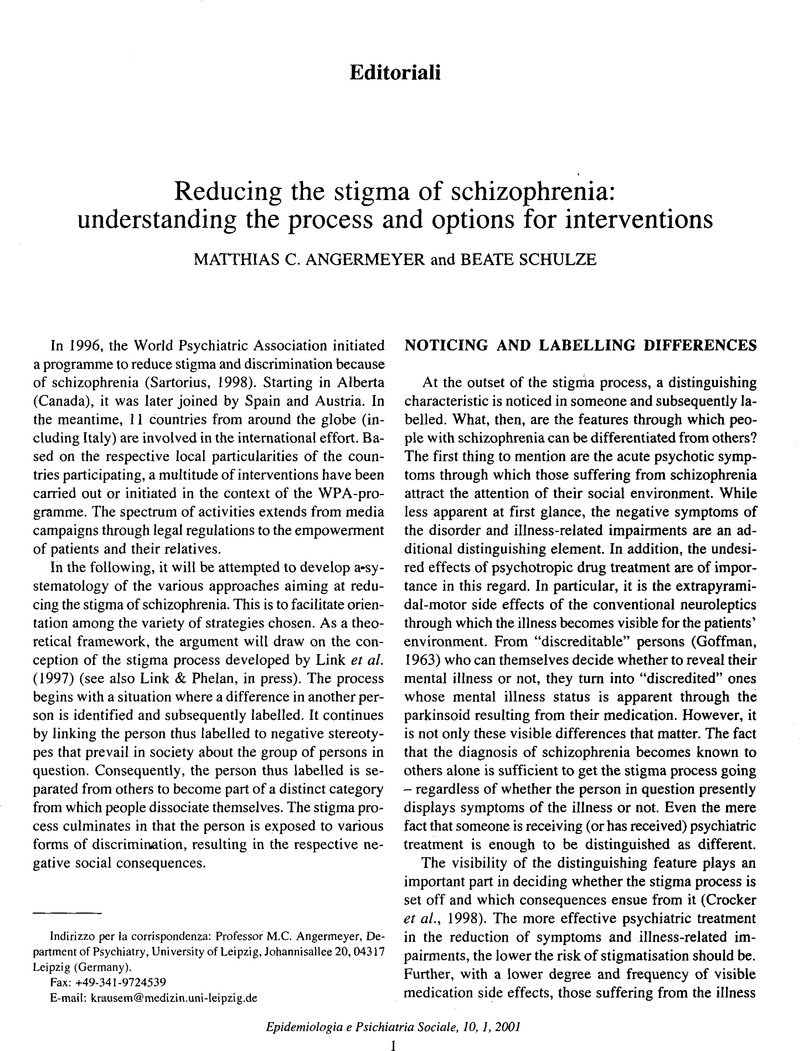Crossref Citations
This article has been cited by the following publications. This list is generated based on data provided by Crossref.
HOLZINGER, ANITA
LÖFFLER, WALTER
MÜLLER, PETER
PRIEBE, STEFAN
and
ANGERMEYER, MATTHIAS C.
2002.
SUBJECTIVE ILLNESS THEORY AND ANTIPSYCHOTIC MEDICATION COMPLIANCE BY PATIENTS WITH SCHIZOPHRENIA.
The Journal of Nervous and Mental Disease,
Vol. 190,
Issue. 9,
p.
597.
Angermeyer, Matthias C
Beck, Michael
and
Matschinger, Herbert
2003.
Determinants of the Public's Preference for Social Distance from People with Schizophrenia.
The Canadian Journal of Psychiatry,
Vol. 48,
Issue. 10,
p.
663.
Stuart, Heather
2003.
Stigma and the Daily News: Evaluation of a Newspaper Intervention.
The Canadian Journal of Psychiatry,
Vol. 48,
Issue. 10,
p.
651.
Angermeyer, Matthias C
Matschinger, Herbert
and
Corrigan, Patrick W
2004.
Familiarity with mental illness and social distance from people with schizophrenia and major depression: testing a model using data from a representative population survey.
Schizophrenia Research,
Vol. 69,
Issue. 2-3,
p.
175.
Pinfold, Vanessa
Thornicroft, Graham
Huxley, Peter
and
Farmer, Paul
2005.
Active ingredients in anti-stigma programmes in mental health.
International Review of Psychiatry,
Vol. 17,
Issue. 2,
p.
123.
Rivera, Carmen Senra
Rossetto, Alexandra De Arriba
Pesqueira, Gloria Seoane
and
Otero, M. José Eerraces
2007.
Attitudes of University Students towards People with Paranoid Schizophrenia.
Psychological Reports,
Vol. 100,
Issue. 1,
p.
325.
González-Torres, Miguel Angel
Oraa, Rodrigo
Arístegui, Maialen
Fernández-Rivas, Aranzazu
and
Guimon, Jose
2007.
Stigma and discrimination towards people with schizophrenia and their family members.
Social Psychiatry and Psychiatric Epidemiology,
Vol. 42,
Issue. 1,
p.
14.
Carpiniello, Bernardo
Girau, Roberta
and
Orrù, Maria Germana
2007.
Mass-media, violence and mental illness. Evidence from some Italian newspapers.
Epidemiologia e Psichiatria Sociale,
Vol. 16,
Issue. 3,
p.
251.
Lasalvia, Antonio
and
Tansella, Michele
2008.
Fighting discrimination and stigma against people with mental disorders.
Epidemiologia e Psichiatria Sociale,
Vol. 17,
Issue. 1,
p.
1.
Verhaeghe, Mieke
and
Bracke, Piet
2008.
Ward features affecting stigma experiences in contemporary psychiatric hospitals: a multilevel study.
Social Psychiatry and Psychiatric Epidemiology,
Vol. 43,
Issue. 5,
p.
418.
Seeman, Mary V.
2010.
Breaking Bad News: Schizophrenia.
Journal of Psychiatric Practice,
Vol. 16,
Issue. 4,
p.
269.
Maggiolo, Davide
Buizza, Chiara
Vittorielli, Michela
Lanfredi, Mariangela
Rossi, Giuseppe
Ricci, Alessandro
Cicolini, Alessia
and
Lasalvia, Antonio
2010.
Patterns of experienced and anticipated discrimination in patients with Schizophrenia. Italian results from the INDIGO international multisite project.
Epidemiology and Psychiatric Sciences,
Vol. 19,
Issue. 4,
p.
314.
Norman, Ross M.G.
Windell, Deborah
and
Manchanda, Rahul
2012.
Examining differences in the stigma of depression and schizophrenia.
International Journal of Social Psychiatry,
Vol. 58,
Issue. 1,
p.
69.
Silverman, Michael J.
2013.
Effects of Music Therapy on Self- and Experienced Stigma in Patients on an Acute Care Psychiatric Unit: A Randomized Three Group Effectiveness Study.
Archives of Psychiatric Nursing,
Vol. 27,
Issue. 5,
p.
223.
West, Keon
and
Turner, Rhiannon
2014.
Using extended contact to improve physiological responses and behavior toward people with schizophrenia.
Journal of Experimental Social Psychology,
Vol. 50,
Issue. ,
p.
57.
West, Keon
Turner, Rhiannon
and
Levita, Liat
2015.
Applying imagined contact to improve physiological responses in anticipation of intergroup interactions and the perceived quality of these interactions.
Journal of Applied Social Psychology,
Vol. 45,
Issue. 8,
p.
425.
Hinshaw, Stephen P.
2015.
Developmental Psychopathology.
p.
841.
Martinez, Andres G.
and
Hinshaw, Stephen P.
2016.
Developmental Psychopathology.
p.
1.
Schlier, Björn
Scheunemann, Jakob
and
Lincoln, Tania M.
2016.
Continuum beliefs about psychotic symptoms are a valid, unidimensional construct: Construction and validation of a revised continuum beliefs questionnaire.
Psychiatry Research,
Vol. 241,
Issue. ,
p.
147.
Ditton-Phare, Philippa
Sandhu, Harsimrat
Kelly, Brian
and
Loughland, Carmel
2022.
Does ComPsych Communication Skills Training Alter Trainee Self-Efficacy?.
Academic Psychiatry,
Vol. 46,
Issue. 3,
p.
303.


